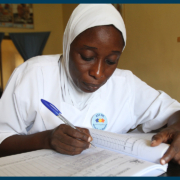Men are still missing: Making family planning more gender-inclusive
International Men’s Day, celebrated every November 19, honors the positive contributions that men make to society and raises awareness about men’s health and well-being. This year’s theme is “Better health for men and boys,” which provides an opportunity to reflect on how the public health community can better support men and boys to live healthy and fulfilling lives with their partners, families, and communities.
In reflecting on this year’s theme as it relates to family planning (FP), we are reminded of a blog post from earlier this year highlighting the Ten Defining Family Planning Achievements of the Decade. This blog post named “making family planning more inclusive” and “ensuring method choice” as two defining achievements between 2010 and 2020. To build on these achievements, we must continue thinking about who is missing from the FP narrative and advance their inclusion. Across the globe, FP is still often considered a “women’s issue” with the primary responsibility for method use placed upon women. In reality, FP is everyone’s issue, and we miss opportunities when we do not engage men and boys given their critical roles in FP as clients, partners, and agents of change.1
Men as Clients: Men have their own unique needs and preferences when choosing, using, and changing FP methods across their lives. While it is important to center the experiences of women and girls as they are primarily the ones who become pregnant and bear children, we must also remember that FP concerns men and boys who have their own unique health needs.
Men as Partners: As equitable and supportive intimate partners, men can help improve FP method use and continuation, reduce unintended pregnancies, and increase healthy birth spacing.2,3 Effective FP programming recognizes men as partners by learning about both men’s and women’s health needs and preferences and by using partner and community communication to address gender dynamics and norms.
Men as Agents of Change: Engaging men as positive agents of change allows us to not only address gender dynamics and norms but also transform them to improve FP outcomes in our relationships, families, and communities.
Vasectomy represents a particular opportunity to increase engagement with men as clients, partners, and agents of change. While tubal ligation, or female sterilization, accounts for 36.9% of FP use in low- and middle-income countries (LMICs), vasectomy accounts for only 0.5%.4,[*] Its comparatively low use is due to multiple factors, including limited availability,5 restrictive gender norms, and misconceptions. Traditional gender norms tie men’s value in society to strength, virility, and procreation, and vasectomy is often viewed as a threat to these masculine “ideals,” even when it may better meet the needs and preferences of some men and couples. We must ensure that vasectomy is an available, accessible, and acceptable option for men and couples who know they do not want to have any or more children.
We can build on the important achievements of the past decade by increasing engagement and deepening partnerships with men and boys around FP. As we continue promoting and advancing FP in different spaces, both clinical and non-clinical, we need to push ourselves to always think about who is missing from the narrative, whether men and boys or other gender-diverse individuals. Men and boys must be neither forgotten nor overlooked; when FP is available, accessible, and acceptable to all, everyone benefits.
RESOURCES
DO’S and DONT’S for Engaging Men & Boys
This practical guidance broadly applies to health promotion and gender equality. The recent best practices and lessons learned directly apply to FP programming and services. The guidance is available in English, French, Portuguese, and Spanish.
Sticking with It: Engaging Men and Boys in Family Planning Across the Life Course
This webinar shares how to put the “Do’s and Don’ts” into practice with real-life examples from research and programming.
Advancing Male Engagement in Family Planning and Reproductive Health: An Advocacy Tool
This tool includes an advocacy implementation plan template that guides users in identifying FP decision-makers, assessing their familiarity with and support for engagement with men and boys, and tailoring their advocacy goal and approach to decision-maker priorities and spheres of influence. The advocacy tool is available in English and French.
[*] China and India account for a large share of the total number of tubal ligation users in LMICs.
References
- Office of Population and Reproductive Health, Bureau for Global Health. (2018). Essential Considerations for Engaging Men and Boys for Improved Family Planning Outcomes. USAID. https://www.usaid.gov/sites/default/files/documents/1864/Engaging-men-boys-family-planning-508.pdf
- Hook, C., Miller, A., Shand, T., Stiefvater, E. (2018). Getting to Equal: Engaging Men and Boys in Sexual and Reproductive Health and Rights and Gender Equality. Washington, DC: Promundo-US. https://promundoglobal.org/resources/getting-equal-engaging-men-boys-sexual-reproductive-health-rights-srhr-gender-equality/
- Pascoe, L., Herstad, M., Shand, T., & van den Heever, L. (2012). Building Male Involvement in SRHR: A Basic Model for Male Involvement in Sexual and Reproductive Health and Rights. Cape Town, South Africa: Sonke Gender Justice Network. https://menengage.org/wp-content/uploads/2014/01/Sonke-Gender-Justice-Model-for-Male-Involvement-in-SRHR.pdf
- Department of Economic and Social Affairs. (2019). Contraceptive Use by Method. United Nations. https://www.un.org/development/desa/pd/sites/www.un.org.development.desa.pd/files/files/documents/2020/Jan/un_2019_contraceptiveusebymethod_databooklet.pdf
- Avenir Health. (2017). Availability of Methods. Track 20. https://www.track20.org/pages/data_analysis/in_depth/opportunities/availability.php
Written by: Danette Wilkins, Program Officer, and Olivia Carlson, Program Officer, Breakthrough ACTION

 Morgana Wingard/USAID
Morgana Wingard/USAID Cambey Mikush/Photoshare
Cambey Mikush/Photoshare Sara Holbak/VectorWorks/Photoshare
Sara Holbak/VectorWorks/Photoshare Sarah Hoibak/VectorWorks/Photoshare
Sarah Hoibak/VectorWorks/Photoshare Rebekah Munnikhuysen/US Peace Corps/Photoshare
Rebekah Munnikhuysen/US Peace Corps/Photoshare Getty Images/Image of Empowerment
Getty Images/Image of Empowerment © 2012 CCP/NURHI 2, Courtesy of Photoshare
© 2012 CCP/NURHI 2, Courtesy of Photoshare